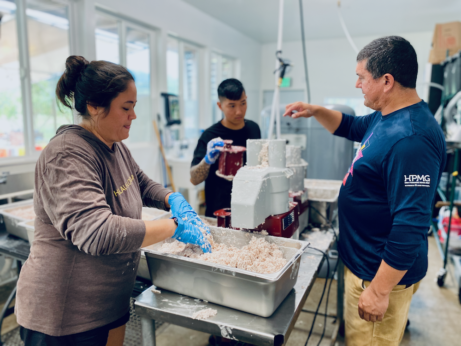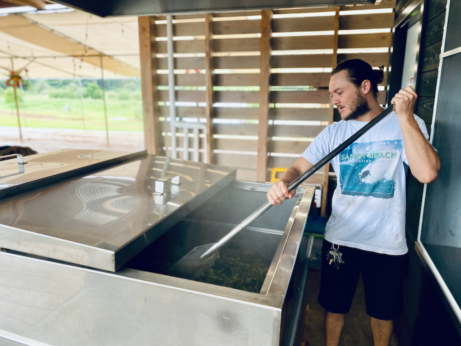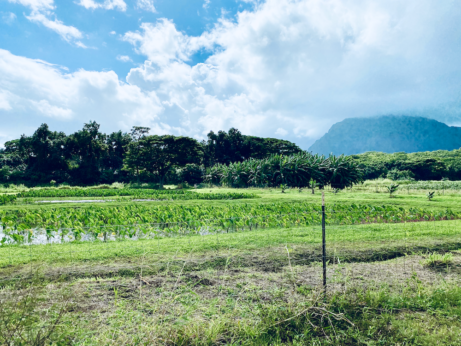Meet the Taro Farmer Restoring an Ecosystem Through Native Hawaiian Practices
Kanekoa Shultz is leading the effort to restore fallowed land into loʻi kalo, the traditional Hawaiian irrigation system used to grow kalo, the Indigenous name for taro.
Meet the Taro Farmer Restoring an Ecosystem Through Native Hawaiian Practices
Kanekoa Shultz is leading the effort to restore fallowed land into loʻi kalo, the traditional Hawaiian irrigation system used to grow kalo, the Indigenous name for taro.

Paepae o’ He'eia fishpond at the mouth of Kaneohe Bay.by Naoki Nitta.
Sprouting deep within the verdant pleats of Oʻahu’s Koʻolau Mountains, Heʻeia stream winds through Kakoʻo ʻOʻiwi, a non-profit organization centered on a six-acre taro farm, before emptying into the wide mouth of Kane‘ohe Bay.
In 2001, executive director Kanekoa Shultz, a marine biologist and seaweed expert, helped rebuild the adjacent Paepae o Heʻeia fishpond. Originally constructed by Native Hawaiians hundreds of years before colonization, the effort resurrected a 1.3-mile rock-walled lagoon used for aquaculture. Yet, when heavy rains repeatedly choked the basin with sediment, Shultz realized that the pond was but one piece of a larger ecosystem in dire need of rehabilitation.
Six years later, Shultz went on to establish Kakoʻo ʻOʻiwi (the name roughly translates to “Helping Native Hawaiians”) on an untended, 405-acre parcel located directly across from the fishpond. Since then, he’s led the incremental effort to restore the fallowed land into loʻi kalo, the traditional Hawaiian irrigation system used to grow kalo, the Indigenous name for taro.
Enlisting a staff of 16 and an army of volunteers, the organization cultivates the crop in knee-deep water diverted from Heʻeia stream. In addition to supplying the community with fresh corms and spinach-like leaves high in calcium and fiber, an on-site kitchen churns out value-added products such as poi, or taro pounded into a starchy staple, and kulolo, a traditional pudding sweetened with coconut milk and raw sugar.
Kakoʻo Oʻiwi’s efforts, however, extend far beyond promoting Native farming traditions and nourishing the community. Its farming practices also help re-establish a vital ecological role: The irrigated ponds absorb floodwater and filter sediment flowing to the sea while the crops create wildlife habitat and curb invasive plant growth. As stewards of both island culture and terrain, “we’re restoring pono—restoring balance to the land,” says Shultz.

Funded largely by private and community donors, it’s a tall order for the scrappy non-profit, which operates under a 38-year lease granted by the state in 2009. The focus on conservation, however, is imperative, he adds, for undoing decades of neglect and mitigating the challenges of a rapidly changing climate.
Heavy, angry water
As a primary food source, kalo holds a reverent place in Native Hawaiian culture, playing a prominent role in its origin story. Before the prevalence of large-scale, Western agriculture, “every valley that had a stream had a kalo plantation,” says Derek Kekaulike Mar, as he helps peel piles of raw taro tagged for a batch of kulolo. A childhood friend of Shultz’s, the frequent volunteer works for a subsidiary of the Hawaiian Native Corporation, a Native-run, nonprofit community impact organization and a Kakoʻo Oʻiwi donor.
Hawaiians traditionally divided land into ahupuaʻa, or self-sustaining units of agricultural production that stretch between the mountains and the ocean. Along with taro patches, the triangular swaths encompassed a range of terrain, from upland timber forests to rain-fed crop fields and orchards in the lowlands. And in many places, they extended to a fishpond—ancient Hawaiians built nearly 500 throughout the islands—with all the pieces connected by a stream.
Recent research has shown that this agricultural system, while only consuming six percent of land, allowed the islands to be self-sufficient in feeding an estimated pre-colonial population of 1.2 million. The study, which was conducted through Kamehameha Schools, a private school system dedicated to educating children with Hawaiian ancestry, concludes that the same methods could feed 86 percent of the state’s current population of 1.4 million—a striking finding for an archipelago that now imports nearly 90 percent of its food while exporting 80 percent of its crops.

Within each ahupuaʻa, a network of taro ponds functioned as surrogate wetlands, regulating the flux of water and removing contaminants flowing downstream. “So the health of the kalo is an indicator of health for the whole ecosystem,” Mar explains.
Colonization and the imposition of private land ownership created seismic shifts in both Native culture and the landscape. As large-scale sugarcane and pineapple plantations began flourishing in the mid-19th century, they consumed land by the tens of thousands of acres and siphoned water supplies, eventually drying up the majority of loʻi kalo throughout the islands.
In the ahupuaʻa of Heʻeia, numerous taro fields had laid fallow since the 1940s, until Kakoʻo Oʻiwi began restoration. Those efforts, however, are integral to a greater system: They bridge the work of Papahana Kuaola, an educational non-profit that keeps upstream waters and forests free of debris and invasive, non-native flora, with the working fishpond located downstream.
Together, the triad works to maintain a clean water supply for the estuary while nourishing a range of Native crops. Besides kalo, both inland organizations cultivate ulu (breadfruit), sweet potatoes and bananas, while the ponds nurture herbivorous fish such as ‘ama’ama (striped mullet), awa (milkfish) and pualu (surgeonfish), as well as crab and shrimp.

The traditional agricultural system also supports native fauna, including the endangered ‘alae ‘ula (Hawaiian moorhen). The red-beaked waterbird, whose population hovers around 1,000, nests in taro patches, making the loʻi kalo a crucial habitat.
Increasingly erratic weather patterns have also made taro farming central to maintaining the health of the ecosystem. The past eight years have brought “more rain bombs,” says Shultz. While rain falls with less frequency, each storm carries more volume, upping the potential for “heavy, angry water.”
Because flood pulses suffocate the estuary, the health of the fishpond and reef beyond is directly dependent on the filtration system, says Shultz. Moreover, kalo fields are remarkably effective at absorbing floodwater. “One acre can bank about a foot of water,” he says. “If you multiply that over a hundred acres—that’s over 30 million gallons of water [banked] per rain event.” Achieve that, and “now you’re actually starting to create some [meaningful] climate adaptation.”
Building a balanced system
Currently, the 50 acres of fields yield approximately 600 pounds of taro a week. Although Shultz’s goal is to triple production, scaling up has its challenges: Cultivation is a year-round, labor-intensive job that involves planting 1,000 bulbs weekly, in standing water, and harvesting an equal amount.
In addition to selling poi and kulolo, the farm is diversifying its revenue stream by incorporating non-traditional practices. “We’re taking care of the land that’s sustained us for thousands of years—in a contemporary system,” says Shultz. “It’s a balance,” much like him, he adds—a Native Hawaiian and a blend of other ethnicities. Along with a mushroom-growing facility in the works, he’s added high-value timber such as mahogany trees; 90 heads of sheep that mow down weeds and other invasive plants; and pigs that consume food and crop scraps such as tough and hairy taro peels. “We’ll be eating those buggers soon,” he says of the livestock. “We sell them, we trade them, we give them away.”
Despite these endeavors, the non-profit currently remains 90 percent dependent on grants. Still, “the biological returns far outpace our agricultural revenues,” says Shultz, and the investment in the land extends far beyond the reaches of the ahupuaʻa.
Between food sovereignty, climate resilience and reviving cultural practices, “you can put all kinds of labels” on these efforts, says Shultz. But, ultimately, they all support one goal: “It’s the ability for us to determine our own future.”
Follow us
This work is licensed under a Creative Commons Attribution-NoDerivatives 4.0 International License.
Want to republish a Modern Farmer story?
We are happy for Modern Farmer stories to be shared, and encourage you to republish our articles for your audience. When doing so, we ask that you follow these guidelines:
Please credit us and our writers
For the author byline, please use “Author Name, Modern Farmer.” At the top of our stories, if on the web, please include this text and link: “This story was originally published by Modern Farmer.”
Please make sure to include a link back to either our home page or the article URL.
At the bottom of the story, please include the following text:
“Modern Farmer is a nonprofit initiative dedicated to raising awareness and catalyzing action at the intersection of food, agriculture, and society. Read more at <link>Modern Farmer</link>.”
Use our widget
We’d like to be able to track our stories, so we ask that if you republish our content, you do so using our widget (located on the left hand side of the article). The HTML code has a built-in tracker that tells us the data and domain where the story was published, as well as view counts.
Check the image requirements
It’s your responsibility to confirm you're licensed to republish images in our articles. Some images, such as those from commercial providers, don't allow their images to be republished without permission or payment. Copyright terms are generally listed in the image caption and attribution. You are welcome to omit our images or substitute with your own. Charts and interactive graphics follow the same rules.
Don’t change too much. Or, ask us first.
Articles must be republished in their entirety. It’s okay to change references to time (“today” to “yesterday”) or location (“Iowa City, IA” to “here”). But please keep everything else the same.
If you feel strongly that a more material edit needs to be made, get in touch with us at [email protected]. We’re happy to discuss it with the original author, but we must have prior approval for changes before publication.
Special cases
Extracts. You may run the first few lines or paragraphs of the article and then say: “Read the full article at Modern Farmer” with a link back to the original article.
Quotes. You may quote authors provided you include a link back to the article URL.
Translations. These require writer approval. To inquire about translation of a Modern Farmer article, contact us at [email protected]
Signed consent / copyright release forms. These are not required, provided you are following these guidelines.
Print. Articles can be republished in print under these same rules, with the exception that you do not need to include the links.
Tag us
When sharing the story on social media, please tag us using the following: - Twitter (@ModFarm) - Facebook (@ModernFarmerMedia) - Instagram (@modfarm)
Use our content respectfully
Modern Farmer is a nonprofit and as such we share our content for free and in good faith in order to reach new audiences. Respectfully,
No selling ads against our stories. It’s okay to put our stories on pages with ads.
Don’t republish our material wholesale, or automatically; you need to select stories to be republished individually.
You have no rights to sell, license, syndicate, or otherwise represent yourself as the authorized owner of our material to any third parties. This means that you cannot actively publish or submit our work for syndication to third party platforms or apps like Apple News or Google News. We understand that publishers cannot fully control when certain third parties automatically summarize or crawl content from publishers’ own sites.
Keep in touch
We want to hear from you if you love Modern Farmer content, have a collaboration idea, or anything else to share. As a nonprofit outlet, we work in service of our community and are always open to comments, feedback, and ideas. Contact us at [email protected].by Naoki Nitta, Modern Farmer
December 15, 2023
Modern Farmer Weekly
Solutions Hub
Innovations, ideas and inspiration. Actionable solutions for a resilient food system.
ExploreExplore other topics
Share With Us
We want to hear from Modern Farmer readers who have thoughtful commentary, actionable solutions, or helpful ideas to share.
SubmitNecessary cookies are absolutely essential for the website to function properly. This category only includes cookies that ensures basic functionalities and security features of the website. These cookies do not store any personal information.
Any cookies that may not be particularly necessary for the website to function and are used specifically to collect user personal data via analytics, ads, other embedded contents are termed as non-necessary cookies.